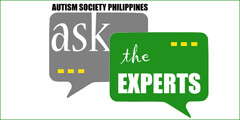By: Dang Koe, ASP Chair Emeritus
 |
| Doing crochet |
My son Gio just turned 17 this month. He has autism. When it comes to handling teens with autism, some parents may get frustrated and confused. What we need to understand is being a teenager is, in itself, challenging. And being a teen with autism is a bigger challenge for parents. Adolescence is a stage of changes and transition. Due to their limitations, teens with autism face greater challenges and need extra help to function more effectively in different settings. A collaborative effort among professionals (physicians, educators, allied health professionals) and government and non-government organizations is necessary to ensure they achieve successful transitions in life. This week’s Angels Talkers Raina Stella Reyes, Joan Dominique Go, & Anna Louisa Tiu are licensed occupational therapists from TW Community Enablers Inc. TWCE recognizes that adolescents with different abilities have the capacity to reach their fullest potential in valued, integrated, and safe life settings.
*****
An occupational therapist (OT) can assist teenagers with autism to lead meaningful and productive lives. OTs can help them participate in everyday activities, whether it be at home, in the community, at work, or in leisure pursuits. For teens with special needs, OTs use practical activities to teach skills so that teens may function in natural settings. Through simulations and practice, discussions, modifying activities, and/or breaking down tasks, OTs can teach teens to attain optimal independence.
Changes and challenges Among the first changes teens will begin to experience are the physical ones. For boys, their voices will sound lower and facial hair will begin to grow. They will begin to wonder why they are suddenly taller than all their female classmates, and why they seem to smell different after gym class. Girls will have their first menstruation, begin to notice that their breasts have enlarged, and they may become more conscious about the pink dots that begin to appear on their faces. Teens with autism, particularly those with sensory processing disorder may perceive growth of facial hair as irritating. For female teens with autism, the use of a sanitary napkin can be exceedingly uncomfortable. Preparation is the key in ensuring that the teen with autism is able to handle these changes. As early as pre-teens, boys with autism can be stimulated around the face (around the cheek and chin area) using a towel or a sponge cloth to reduce irritation due to growth of facial hair. Pre-teen girls with autism can also be asked to wear sanitary napkins or panty liners for a few hours per day in anticipation of the onset of menstruation). Your teen will also be developing cognitively. Teenagers begin to have a better understanding of abstract concepts. Thus, parents need to be equipped with answers to questions that dwell around topics such as love, respect, honesty, faith, and nationalism. At the same time, teenagers still have a tendency to demonstrate a form of egocentrism that leads them to believe that everything happens only to them. This leads to other emotional and behavioral changes that make them appear rebellious, aggressive or, at times, overdramatic. For teens with autism, they have limitations in understanding subtle social cues which become imperative in establishing mature relationships. They are also concrete learners, making it difficult for them to understand abstract cues, such as “respect” or “responsibility”.
Teaching abstract concepts and social skills To help the teen with autism understand abstract concepts, the OT usually teaches these concepts in the context of everyday situations in different settings and with the use of visual aids. For instance, instead of simply defining the term “respect”, the teen with autism is shown pictures and/or videos of instances and circumstances in which respect was demonstrated and not demonstrated (e.g. using a normal tone of voice as opposed to answering back and raising one’s voice when talking to parents).
Stories may also be used to clarify abstract concepts. Psychoanalyst Erik Erikson regards the period of adolescence as a tug-of-war between identity and role confusion, and more often than not, adolescents tend to derive their identity from their “barkada” or their constant group of friends. Adolescents feel the increased need to belong and tend to succumb easily to peer pressure. Their physical and social environment also expands from being confined to their home and school, to attending parties and hanging out with friends. Teens with autism may have difficulty in understanding the difference between private and public places. Also, given the misconceptions regarding disability, they also face increased difficulty in adapting to the norms of society, and have to work harder to be accepted and loved by a peer group. This is the reason it is necessary to help the teen with autism identify why it is important to interact with others and to teach them social skills. There are many teens with autism after all who do not socialize with others only because they are aware that they are not as adept as their peers. Simulations and practice can initially be done to train this; sessions can be videotaped to help the teen with autism see how he acts, what he did correctly, and what he can improve on. The teen can later on be placed in situations where he needs to apply these skills (e.g. introducing him to a new person, making him join a club or organization, organizing a day or nigh out with him and his classmates in school, etc.).
Teaching them to deal with problems Most teenagers resolve conflicts on their own, but teens with autism and other special needs are faced with even greater challenges. More often than not, teenagers with autism can only act on a problematic situation that they have already experienced. When faced with a new one, their responses are usually either inappropriate or ineffective (e.g. would cry, throw tantrums, or panic). In order to help them, teens with autism can be taught to systematically solve problems (that is, in a step-by-step manner). This can be done through the use of worksheets, videos, and/or pictures where the teen with autism is helped to identify problems and come up with solutions to problems. Simulations and practice in real settings can also be done to assist the teen with autism handle conflicts or problems effectively.
Teaching responsibility and independence Finally, recognizing that adolescence as a period of increased responsibility and independence, adolescents are faced with the added challenge of adapting to new life roles beyond school. The OT, in particular, builds on the skills teens already possess such as counting, letter identification, basic reading, basic computation, etc. For example, instead of counting objects, the teen is taught to recognize and count money in preparation for grocery shopping. Instead of reading a set of words, the teen with autism is guided to recognize road and/or street signs to help him/her go around the community or a new place (e.g. when on vacation) safely. Their occupations (defined as valued and meaningful activities) evolve from simply playing and studying, to planning on how to save their weekly allowance, learning how to drive, forming mature relationships, and applying for college. While most teens have the freedom to select what “they want to be when they grow up”, the options for teens with special needs in our country are limited. Although, RA 7277 (The Magna Carta for Persons with Disabilities) states that “no PWD shall be denied access to opportunities for suitable employment” a large number of adults with disabilities remain to be unemployed due to both a lack of training to achieve the necessary skills and the lack of awareness and opportunities for employment. OTs can also evaluate work potential and train work skills of teens with special needs to give them a fair chance at employment and also to explore their work options.
Equipping the teen with autism Ideally, pre-teeners (10-12 years) and teens with autism are prepared for life after school; and those who wish to attain skills to improve performance at home in the community, in leisure pursuits, or at work. OT evaluation includes looking at the teen’s adaptive and everyday skills, interests, work-related and work skills. Long term goals are developed in coordination with the teen, the parents, and other valued members of the immediate community. Training is conducted on an individual or group basis (depending on the needs of the teen) in any or all of the following areas: Home, community, leisure, and/or work. An ideal setting will be a simulated office, a library, a bedroom, and a kitchen which are necessary for teens to learn how to function independently in different settings. To help the teen with autism assimilate, the teen can be taken to different establishments, such as restaurants, banks, and stores that will allow for practice of community skills in their actual context. The main goal of occupational therapists is to help the teen with autism become independent and contributing members of society, by providing them the guidance needed to successfully attain important and life-changing milestones.
Uploaded with Permission Acknowledgement to Manila Bulletin: What's the next step for my teen with autism?
*****
Autism Society Philippines thanks all its members, volunteers, partners, supporters and sponsors for the successful nation-wide celebration of the week-long
15th National Autism Consciousness Week from January 16-23.
Thank you, angels!






0 comments:
Post a Comment